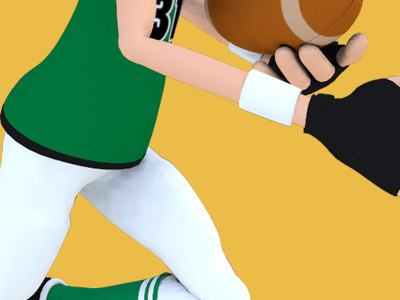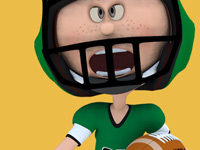American football

American Football Motion
In gridiron football, motion refers to the movement of an offensive player at or prior to the snap.
Motion and shift
There is a distinction drawn between a shift and motion in football. A shift occurs when one or more players changes their position on the offensive side of the ball before the snap, causing a change in formation. For example, players may line up initially in an I-formation and then shift the two running backs into wide receiver positions to put the offense in a spread formation. A team may shift any number of players into new positions, so long as they all come to a complete stop for a full second before the ball is snapped to start the play.
Motion occurs when a player is moving at the time of the snap. While different leagues have different rules regarding motion, most mandate that no more than one player may be in motion at the time of the snap, and that only players who start in "back" positions (running backs, fullbacks, quarterbacks, flankers, H-backs, etc.) may be in motion at the snap. Additionally, the NFL (professional), NCAA (college), and NFHSAA (high school) require that they be moving laterally or backwards, and are not allowed to move towards the line of scrimmage. The Canadian Football League and the Arena Football League allow for motion towards the line of scrimmage.
The National Football League defines all motion and shift penalties as "illegal motion", while both the NCAA and NFHSAA make a distinction between an "illegal shift" and "illegal motion"; an illegal shift refers to players shifting and not coming to a complete stop before the snap while illegal motion refers to a player who is in motion towards the line of scrimmage, or a player who is not a "back" in motion. In both leagues, however, the penalty for illegal motion/illegal shift is five yards from the previous spot and replay the down.
Additionally, the offensive team may be charged with the penalty of a "false start" if a player on the offense jumps or moves abruptly, simulating the start of the play. This movement is not normally considered a subset of the "motion" or "shift" rules, as the player is not judged to be moving into a new pre-snap position; they are merely starting the play too soon. This is also a five-yard penalty.
Requirements
In all forms of football, only players in the backfield and not on the line of scrimmage may be in motion at the time of the snap. Prior to starting the motion, all players on the offensive side must be in a set formation for a minimum of one second.
In most versions of American football, only one player may be in motion at one time, and the player must not move toward the line of scrimmage in his motion (in other words, he can only move laterally or backward). In no situation may the moving player begin on the line of scrimmage when he moves (in other words, offensive linemen are prohibited from motion prior to the snap). Any player who shifts from a lineman position to a back position must set in position at least five yards behind the line of scrimmage before going into motion.
SPORTS



American Football
Game play in American football consists of a series of downs, individual plays of short duration, outside of which the ball is dead or not in play. These can be plays from scrimmage – passes, runs, punts, or field goal attempts (from either a place kick or a drop kick) – or free kicks such as kickoffs and fair catch kicks. Substitutions can be made between downs, which allows for a great deal of specialization as coaches choose the players best suited for each particular situation. During a play, each team should have no more than 11 players on the field, and each of them has specific tasks assigned for that specific play.
Rules and gameplay
- Scoring
- Maneuvers
- Strategy
- Play types
- Penalties
- Turnovers
- Downs
- Teams and positions
- Field
- Equipment
- Duration and time stoppages
- Advancing the ball and downs
- Kicking
- Officials and fouls
Positions
Offensive (Interior) line
Backs and receivers
Defensive line
Linebackers
Defensive backs
Special teams
- Kicker (K)
- Holder (H)
- Long snapper (LS)
- Punter (P)
- Kickoff specialist (KOS)
- Kick returner (KR) and Punt returner (PR)
- Upback
- Gunner
- Jammer


RESOURCES
This article uses material from the Wikipedia articles "American football", "American football rules", "Motion (gridiron football)", which is released under the Creative Commons Attribution-Share-Alike License 3.0.
© Stories Preschool. All Rights Reserved.





